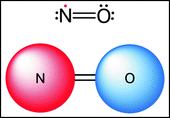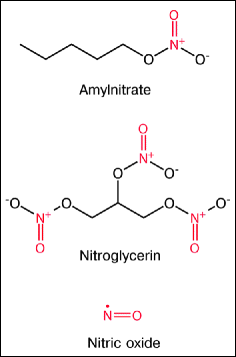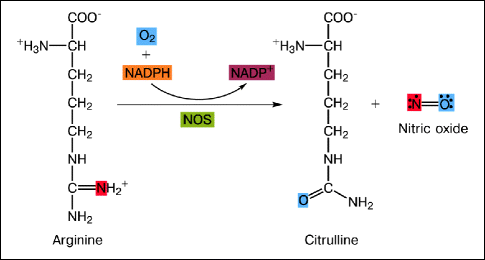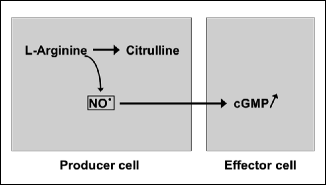, Maneli Mozaffarieh1 and Hans Bebie2
(1)
Department of Ophthalmology, University of Basel, Basel, Switzerland
(2)
Institute for Theoretical Physics, University of Bern, Bern, Switzerland
Abstract
Nitric oxide (NO) is a diatomic free radical consisting of one nitrogen and one oxygen atom (Fig. 12.1).
12.1 Nitric Oxide Molecule
Nitric oxide (NO) is a diatomic free radical consisting of one nitrogen and one oxygen atom (Fig. 12.1).


Fig. 12.1
Molecular structure of nitric oxide and its chemical structure, showing that it is a free radical (dot: an extra electron). NO is only slightly polar, making it soluble in both water and lipids
Nitric oxide is both lipophilic and small, so it can easily pass through cell membranes. In its natural form, it is a colorless gas. This gas is distinct from and not to be confused with nitrous oxide (N2O), also known as laughing gas, which is used for anesthetic purposes.
This molecule has a history as one of the components of air pollution. Nevertheless, it also plays such an important role in physiological and pathophysiological processes that, in 1982, the journal Science named nitric oxide as its choice for “Molecule of The Year.”
Before we discuss the involvement of nitric oxide in a variety of biological processes, we shall briefly discuss the discovery of nitric oxide.
12.2 Nitric Oxide in History
The mechanism of blood circulation was not very well understood before the seventeenth century, when Harvey1 established the heart as the center of the blood system and showed that blood circulates to and from the heart. While researching a cure for the heart disease angina, physicians began experimenting with amyl nitrite, which seemed to reduce both blood pressure and angina pain. As its effectiveness was short-lived, they began researching related chemicals. One related chemical compound was nitroglycerin (Fig. 12.2), a compound formed by the combination of glycerol and nitric and sulfuric acids.


Fig. 12.2
Nitrogen oxides. The chemical structure of amyl nitrite (top), nitroglycerin (middle), and nitric oxide (bottom). Both amyl nitrite and nitroglycerin liberate nitric oxide (NO)
Pure nitric oxide was first synthesized by the Italian chemist Sobrero.2 In his private letters and in a journal article, Sobrero warned vigorously against the use of this compound because of its explosive properties, stating that it was extremely dangerous and impossible to handle. In fact, he was so frightened by what he had created that he kept it a secret for over a year.
Nevertheless, the word got out. Four years after Sobrero’s discovery, Nobel3 learned about nitroglycerin’s explosive properties. In 1863, after extensive experimentation, Nobel (Fig. 12.3) found that, when nitroglycerin was incorporated in an absorbent inert substance such as kieselguhr (diatomaceous earth), it became more convenient to handle, and he patented this mixture in 1867 as “dynamite.”


Fig. 12.3
Alfred Nobel
During the development of nitroglycerin, workers discovered that they developed headaches when they came into contact with the compound (the workers called it the “nitro headache” ). This suggested to the physician Murrell4 that nitroglycerin could act as a vasodilator, much like the previously discovered amyl nitrate, and could be used as a treatment for cardiac angina. In 1876, Murrell first used nitroglycerin for angina, yet because he was worried that his patients would be alarmed at the prospect of ingesting explosives, Murrell marketed his finding as “glyceryl trinitrate.”
Much later, in 1978, Furchgott5 recognized that acetylcholine induced vasorelaxation only if vascular endothelium cells (VEC) were present. Ignarro6 found that a substance he called “endothelium-derived relaxing factor” (EDRF) was released by VEC. By 1986, Murrad7 had found that EDRF was, in fact, nitric oxide (NO) (Fig. 12.4). Furchgott, Ignarro, and Murrad jointly received the Nobel Prize in 1998.


Fig. 12.4
Robert F. Furchgott, Louis J. Ignarro, and Ferid Murrad
12.3 Nitric Oxide in Biology
Nitric oxide (NO) is a highly reactive molecule with a half-life in biological tissues of only a few seconds. Indeed, the half-life of NO is so short that it acts locally and its concentration is not homogenous even within a cell. Because it is small and liposoluble, it can easily diffuse across membranes. These attributes make nitric oxide ideal for a paracrine (between adjacent cells) and autocrine (within a single cell) signaling molecule. Indeed, NO is one of the few gaseous signaling molecules known. A signaling molecule is a chemical that transmits information within and/or between cells. NO is synthesized in living cells from the amino acid L-arginine, as shown in Fig. 12.5.


Fig. 12.5
Synthesis of nitric oxide from arginine and oxygen by various nitric oxide synthases (NOS)
This reaction is catalyzed by a group of enzymes called nitric oxide synthases (NOS). There are three types: neuronal NOS (nNOS = NOS1), which produces NO in neuronal tissue, inducible NOS (iNOS = NOS2), which can mostly be found in the immune cells, and endothelial NOS (eNOS = NOS3 = cNOS), which is constitutively expressed in vascular endothelial cells. NOS1 is always present in all neuronal cells, while the expression of NOS2 occurs when “induced” by a variety of factors (Table 12.1).
Table 12.1
Nitric oxide synthase enzymes – comparisons of the different human NOS enzymes
nNOS NOS1 | Chromosome 12 | Ca++ dependent |
iNOS NOS2 | Chromosome 17 | Ca++ independent |
eNOS NOS3 | Chromosome 7 | Ca++ dependent |
Let’s take a closer look at NOS3. In blood vessels, an equilibrium exists between endothelium-derived vasoconstriction and endothelium-derived vasodilation. If this equilibrium is disturbed by inhibition of the production of a molecule such as NO, the “net result” is vasoconstriction. Therefore, a basal production of NO is a prerequisite to keep the vessels dilated. The necessary enzyme, NOS3, is constantly expressed in vascular endothelial cells. Its activity to produce NO depends on cytosolic calcium concentration. Molecules such as acetylcholine (Fig. 12.6) or bradykinin stimulate NOS and thereby increase NO production.


Fig. 12.6
Acetylcholine, in addition to bradykinin, is the major stimulator of NO production. Interestingly, this molecule is also a neurotransmitter and can be used to constrict the pupil intraoperatively
If NO diffuses into neighboring smooth muscle cells or pericytes, it stimulates the enzyme guanylate cyclase, thereby leading to increased production of cyclic guanine monophosphate (cGMP) (Fig. 12.7). This leads to a variety of effects depending on the cells. In the case of smooth muscle cells and pericytes, NO promotes relaxation and, therefore, vasodilation.


Fig. 12.7
The effect of nitric oxide diffusing into neighboring cells. Nitric oxide (NO) production leads to an increase in cyclic guanosine monophosphate (cGMP) in neighboring cells. The effect of cGMP depends upon the cell type. In smooth muscle cells, it promotes relaxation (From Mozaffarieh M, Flammer J (2009) Ocular blood flow and glaucomatous optic neuropathy. Springer Publ, Berlin. With permission)
Is NO a good or a bad molecule? On its own, it is vasodilatory and neuroprotective. However, if it is present in the vicinity of free oxygen radicals, it has a detrimental effect.
12.4 Nitric Oxide in Medicine
As mentioned above, NO, by itself, is actually a good molecule and is, therefore, used therapeutically. However, it reacts quite rapidly with many other radicals, including the oxygen radical superoxide anion (O2•−), generating harmful peroxynitrite (ONOO−) (Fig. 12.8). In fact, in a variety of nitrosylation disorders of SH-groups frequently occur in diseased tissues. SH-groups react either with NO or (more damaging) with peroxynitrite (Fig. 12.9). This has been shown in neurodegenerative diseases, atherosclerosis, rheumatoid arthritis, adult respiratory distress syndrome, cancer, and others.






Fig. 12.8
Formation of peroxynitrite (ONOO−). Nitric oxide reacts with the superoxide anion to form the highly damaging peroxynitrite
< div class='tao-gold-member'>
Only gold members can continue reading. Log In or Register to continue
Stay updated, free articles. Join our Telegram channel

Full access? Get Clinical Tree


